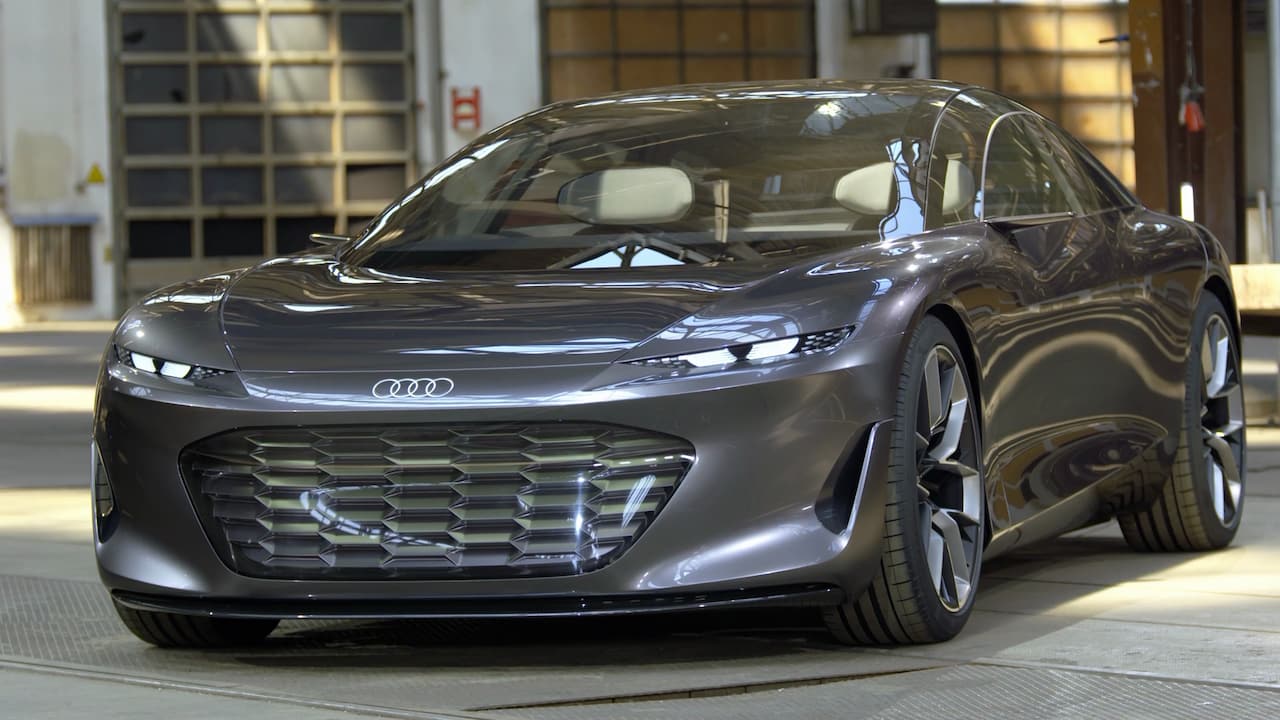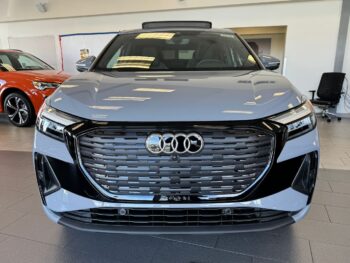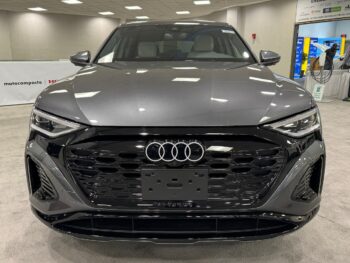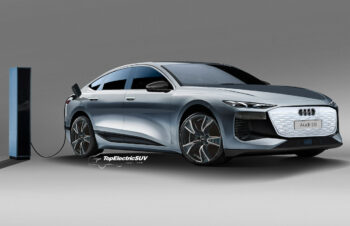Update: ‘Platform’ sub-section of ‘Specifications’ and ‘Release Date’ section updated.
The Audi Landjet looks set to take four-ringed brand into the future of motoring, and here’s everything we know about the next-generation Audi electric car:
Design
According to a Top Gear report dated September 30, 2022, the Audi grandsphere concept, unveiled in 2021, is the precursor to the highly anticipated Audi Landjet model. Oliver Hoffmann, BoM member responsible for Technical Development, Audi, told the British publication that the show car “gives a clear view to the first Artemis car.” Hoffmann went on to state that Audi will use both exterior and interior design of the open-top sphere concept for the dealer-bound EV.
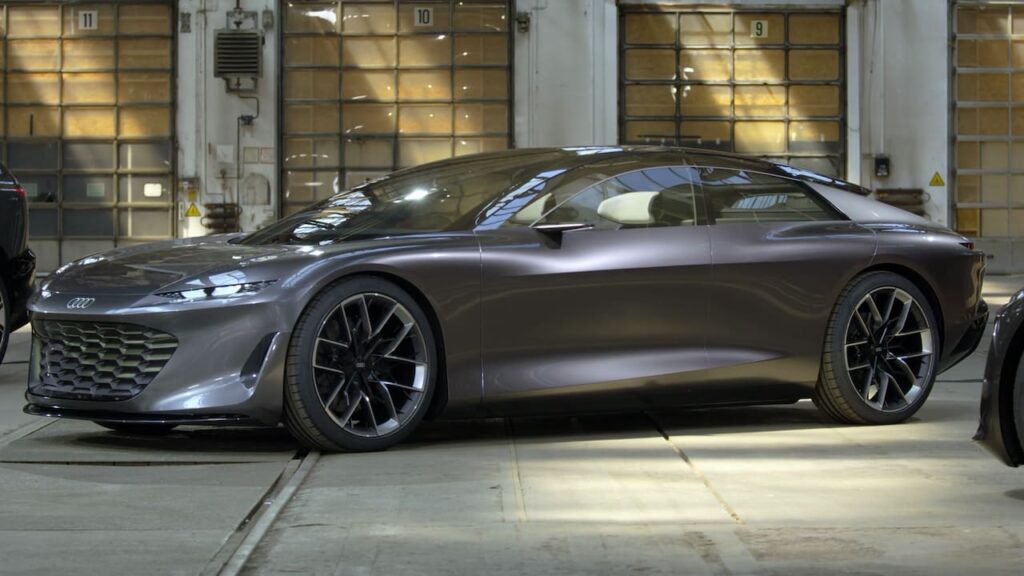
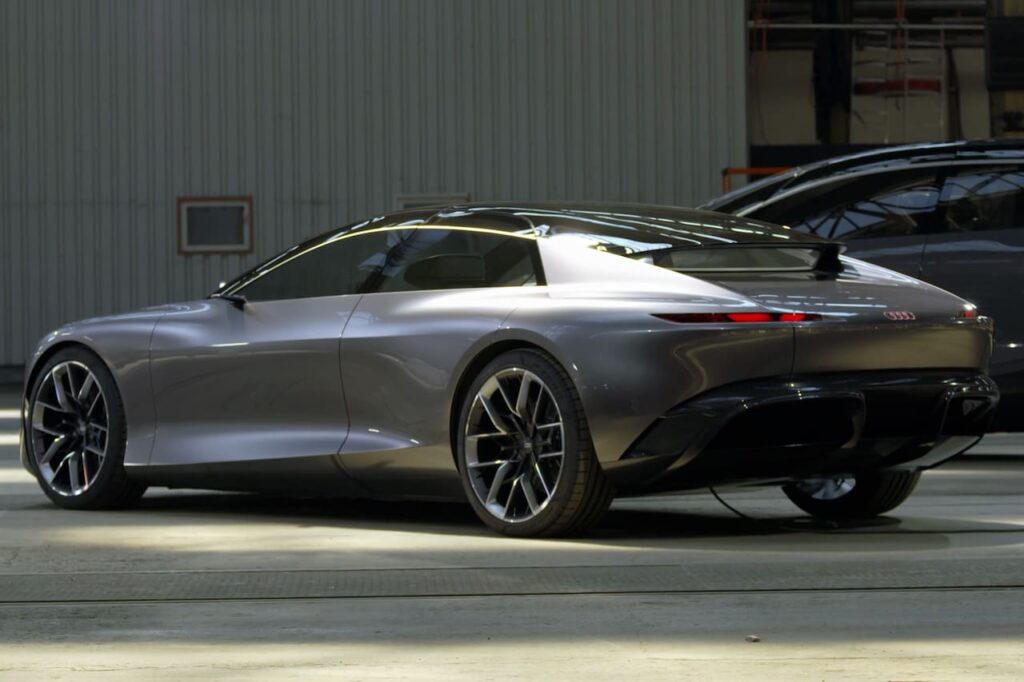
The Audi grandsphere is a low-slung, highly aerodynamic, avant-garde four-door. It’s no ordinary sedan by any means. It blends the characteristics of a grand tourer and a shooting brake as well. And interestingly, it’s almost impossible to figure that out if you’re looking at it from the front three quarters. The designers have discretely packaged the dramatic proportions at the rear.
The Audi grandsphere concept has a striking appearance at the front with the concave hexagonal Singleframe and the narrow headlights that look like focused eyes. On the sides, the chief design element is the dynamically sloping arc of the roofline akin to Audi Sportback models. Also worth noting are the 23-inch wheels inspired by the Audi Avus from the 1990s. As for the rear, the boat tail looks like a piece of art, and would be the talking point if translated into production.
Interior
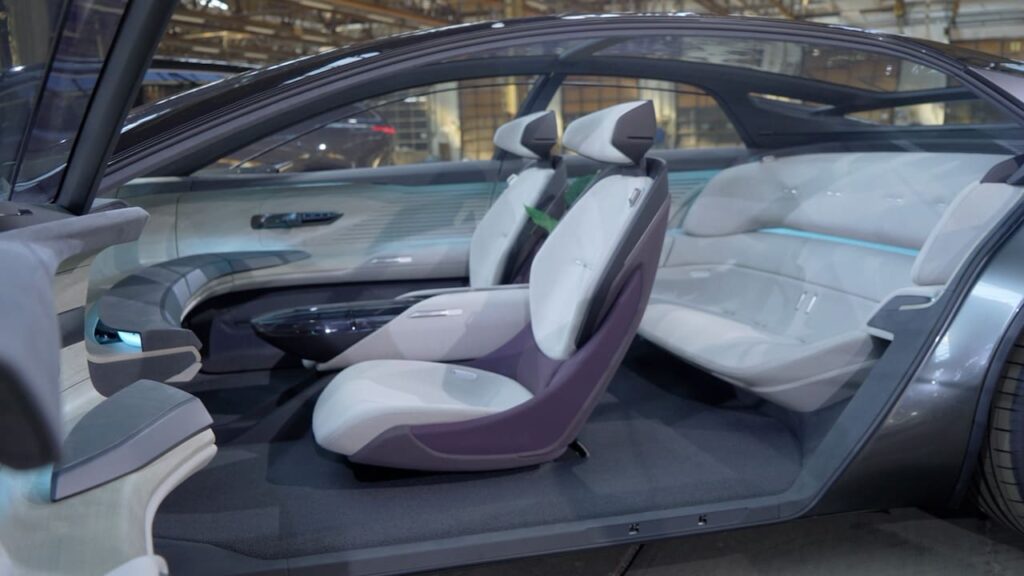
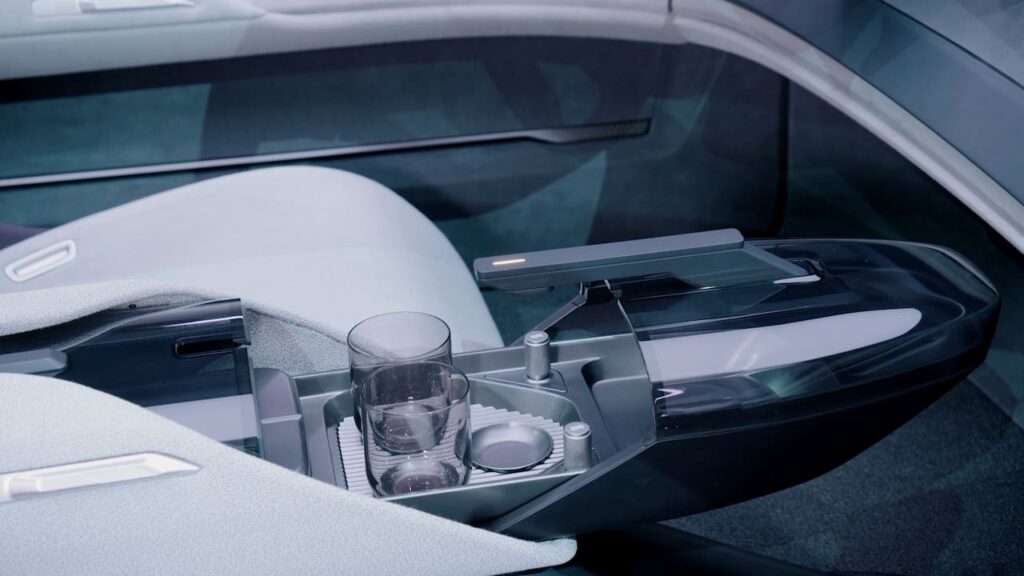
The real highlight of the Audi grandsphere is its futuristic interior. In fact, getting the interior right was so important in this case that Audi designed the concept from the inside out. The company is reimagining the interior of its cars with the trio of sphere concepts (Skysphere, Grandsphere, and Urbansphere) for the future when autonomous driving will be the new normal.
With reversed rear doors and no B-pillars, the grandsphere concept gives a grand welcome to its occupants, and in no time, the sense of spaciousness, opulence, and future forwardness starts reeling in. The 2+2 seater provides the most attractions for the passengers in the front seats, not in the rear seats like traditional sedans. It’s ready for Level 4 autonomous driving, on enabling which the steering wheel and pedals disappear. There’s no traditional dashboard either, and effectively, the car becomes a spacious first-class lounge.
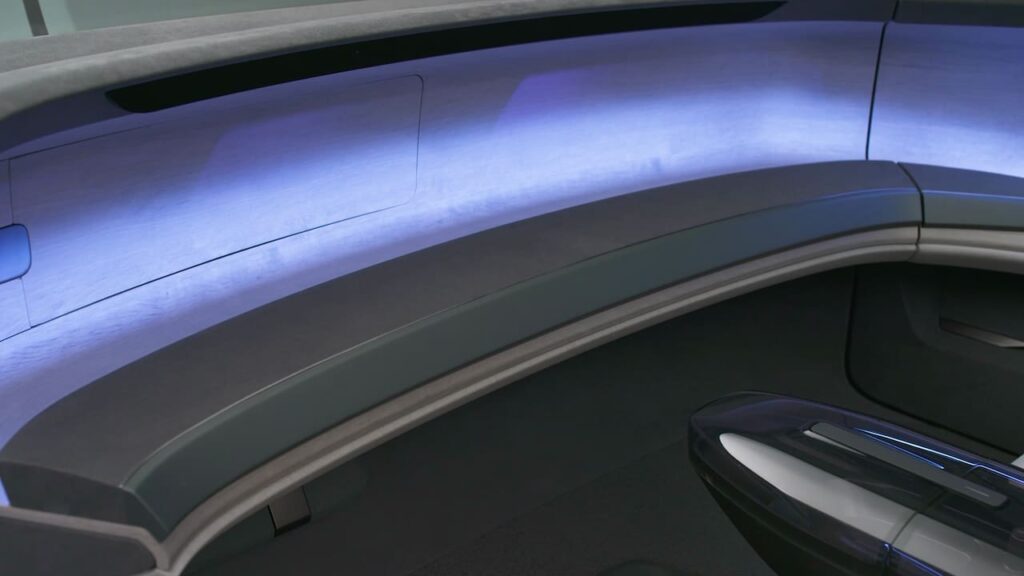
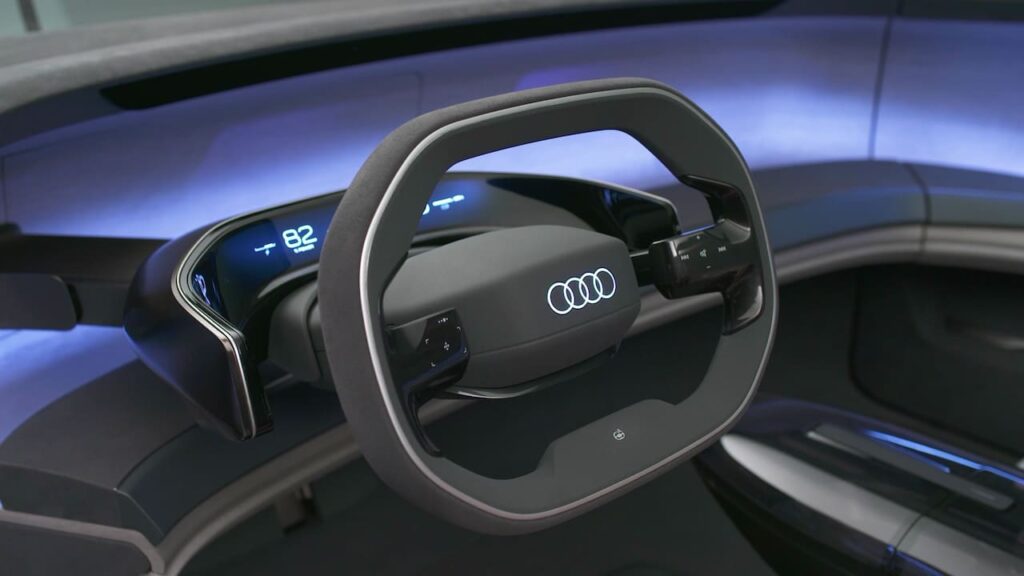
The Audi Landjet should be a revolutionary product at Audi, and that’s exactly how Marc Lichte, Head of Design, Audi, described the project while speaking to caranddriver.com in December 2020. At Volkswagen Group’s Power Day event in March 2021, Markus Duesmann, CEO, Audi, had hinted that the development of the dealer-bound Audi Landjet concept (the Audi grandsphere) will begin shortly.
After almost nine months, we have now reached an important project milestone and successfully completed the concept phase for the first model based on the Artemis. We are now starting serial development of this project.
Markus Duesmann, CEO, Audi, in March 2021 (Volkswagen Group Power Day)
Neither an ‘A’ nor a ‘Q’ model
In an interview with Wirtschafts Woche in January 2021, Duesmann discussed the branding of the Landjet. He said that “the first from the new Artemis e-car business unit,” internally called Audi Landjet, will belong to a “new vehicle category.” It will be neither a large sedan positioned above the Audi A8 (and thus not an Audi A9) nor a large SUV positioned above the Audi Q7. It’s not an “A or Q” series car, Duesmann confirmed.
Traditional grille
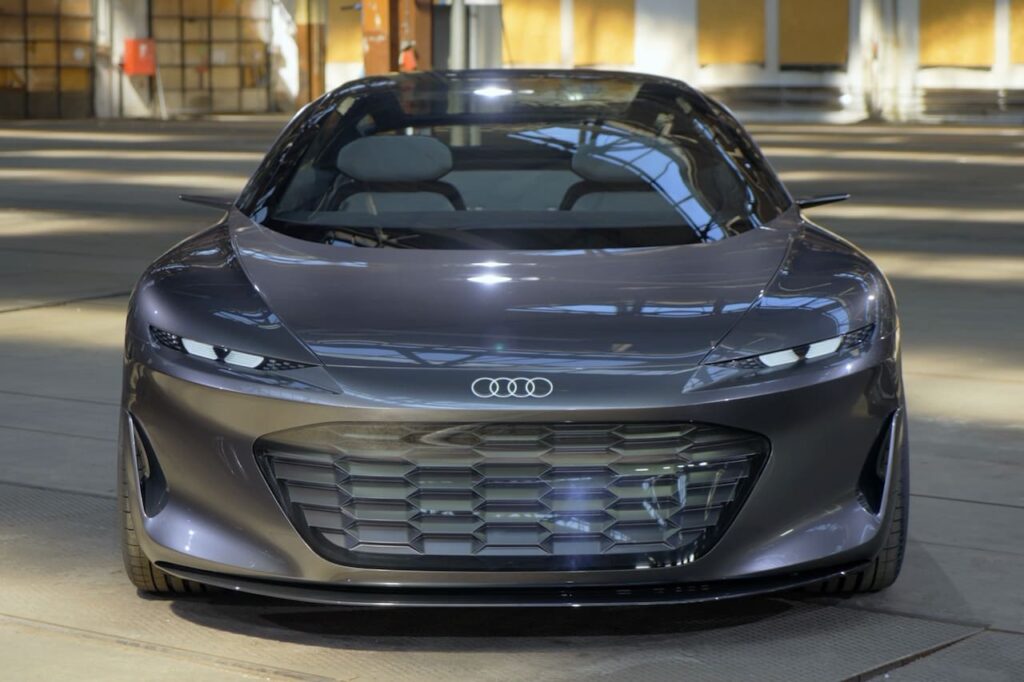
While all developments so far indicate an unconventional design for the Audi Landjet, some things are likely to be traditional. For instance, the front-end of the car will likely feature a Singleframe grille. Singleframe is a signature design element of Audi, and it won’t go away despite the fact that EVs don’t need large grilles
The German automaker has said that the Singleframe grille will appear on even self-driving Audi models, MotorTrend reported on July 19, 2021. The large front grille is as crucial to aesthetics as functionality, perhaps even more so in the EV era where designs are changing drastically with the flexibility that electric powertrains provide. It will continue being a part of the “electric face,” as the company’s designers refer to the front-end of Audi EVs.
New materials
Norbert Weber, head of Interior Design, Audi, has suggested that the company will use alternative interior materials that are easy on both environment and animals in its upcoming EVs. Speaking to CarBuzz, he said that the company is developing vegan materials and considering surrogate leather. Soon, Audi models will have new materials, textures, and fabrics, the design chief added.
Specifications
Platform
According to a report Automobilwoche released on December 5, 2022, an ‘SSP 61’ platform, a version of the Scalable Systems Platform (SSP), will underpin Audi Artemis models. Previously, during Volkswagen Group’s New Auto strategy announcement, Duesmann confirmed mixed usage of PPE and SSP elements as well as a unified battery cell format.
With the Audi Artemis model, we will be spearheading major modules of the SSP starting in 2025. It symbolizes the transition from the PPE platform to the SSP. And with E3 2.0 and the new unified battery cell format, it already brings an important part of the SSP into serious production from 2026 onwards.
Markus Duesmann, CEO, Audi (Volkswagen Group New Auto strategy 2021)
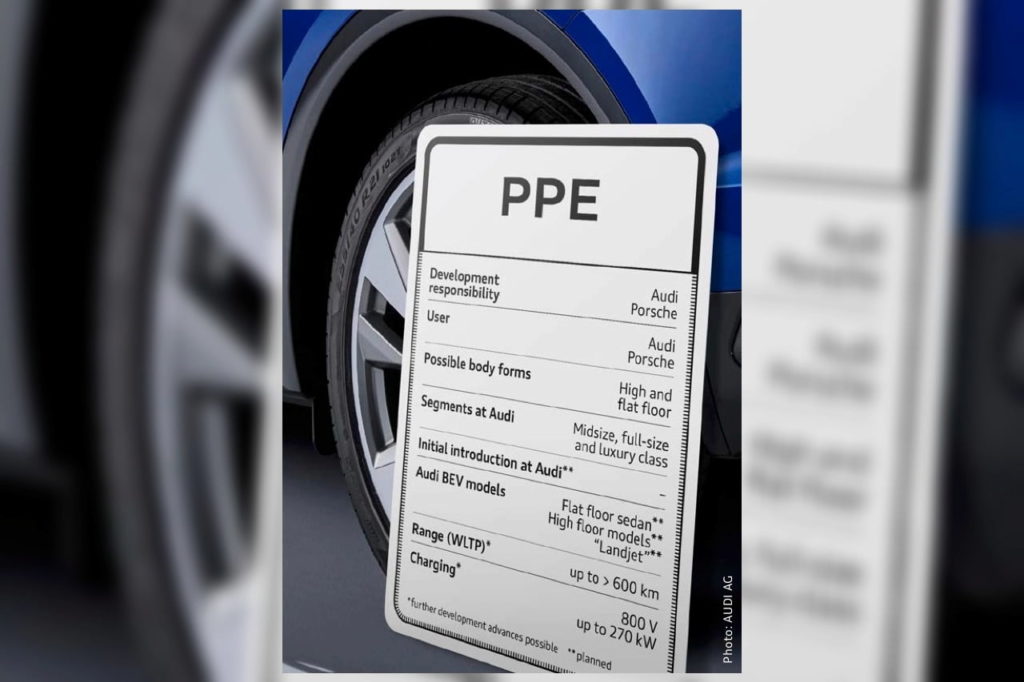
Duesmann indicated at Volkswagen Group’s Power Day event that the Audi Landjet will debut the parent company’s unified battery cell format, which offers the best conditions for the eventual transition to solid-state battery technology. He said:
The model (Artemis) will play a key role in its respective model series. Among other things, it will be the spearhead of our electronic platform. This first model based on Artemis will also be the first one to use a new unified battery cell format.
Markus Duesmann, CEO, Audi (Volkswagen Group Power Day 2021)
At the Audi Annual Media Conference 2022 on March 17, 2022, Oliver Hoffmann reaffirmed that the Audi Artemis model will be Volkswagen Group’s first EV to feature battery cells built with unified technology.
In the Group we also opted for a streamlined, harmonized cell technology and the Artemis project, which customers will see in 2025, this harmonized cell format will be applied for the first time in a Group vehicle. Audi has a pioneering role in that, and it also ties in with this unified technology in terms of achieving a volume effect as well.
Oliver Hoffmann, BoM member – Technical Development, Audi (Audi Annual Media Conference 2022 on March 17, 2022)
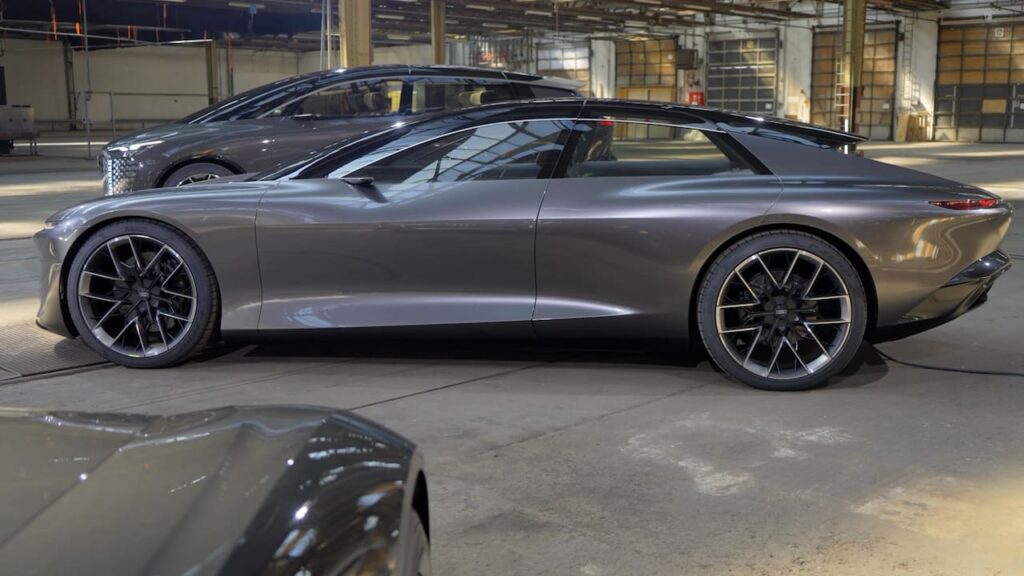
By 2030, the SSP will cover a bigger volume than the PPE and the MEB put together. Volkswagen Group wants to sell more than 40 million vehicles based on the SSP over its lifetime. Duesmann said at the New Auto strategy announcement event that the rollout of the new mechatronics platform and the related reduction in complexity will be faster than ever before.
Battery & Motor
The grandsphere concept offers clues on what Audi has in mind for its new electric flagship and next-gen born-EV models. The grandsphere has two electric motors, one on the front axle and the other on the rear, generating 530 kW (710 hp) of combined power and 960 Nm (708 lb.-ft.) of combined torque. Feeding these high-output motors is a 120 kWh battery pack that can provide a range of more than 750 km (466 miles) when driving efficiently. This would be in the ballpark of the Mercedes EQS sedan which does 770 km (478 miles) in the WLTP metric.
The system voltage is double the norm – 800 volts, so rapid or ultra-fast charging is possible. The maximum DC charging rate is 270 kW, and it allows charging from 5 to 80% in less than 25 minutes. Just ten minutes of charging can provide a range of more than 300 km (186 miles).
Dedicated charging network
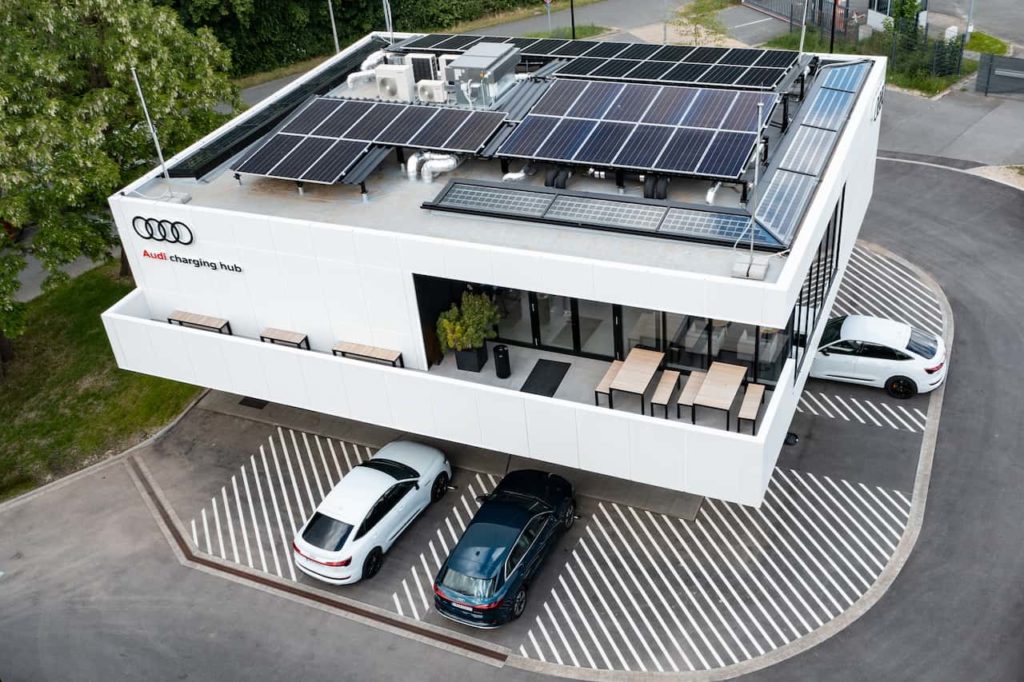
Audi is rolling out a high-power charging (HPC) network across Europe that is exclusive to its customers. The company opened a pilot HPC outlet with six reservable charging points with up to 320 kW in Nuremberg, Germany, in 2022. A second compact pilot site is coming up in Zurich, Switzerland by December 2022, followed by more sites in Salzburg and Berlin in Germany. The company’s home market will get additional charging stations in 2023 and 2024. These would be accessible to customers of the Audi Landjet.
New vehicle software architecture
The Audi Artemis will debut a new-generation vehicle software architecture called E³ 2.0, and CARIAD will be responsible for the development of the same. Dirk Hilgenberg, CEO, CARIAD, announced this development at Volkswagen Group’s New Auto strategy announcement event. He said:
We will integrate our stack 2.0 in Audi’s Artemis project for the first time in 2025.
Dirk Hilgenberg, CEO, CARIAD (Volkswagen Group New Auto strategy 2021)
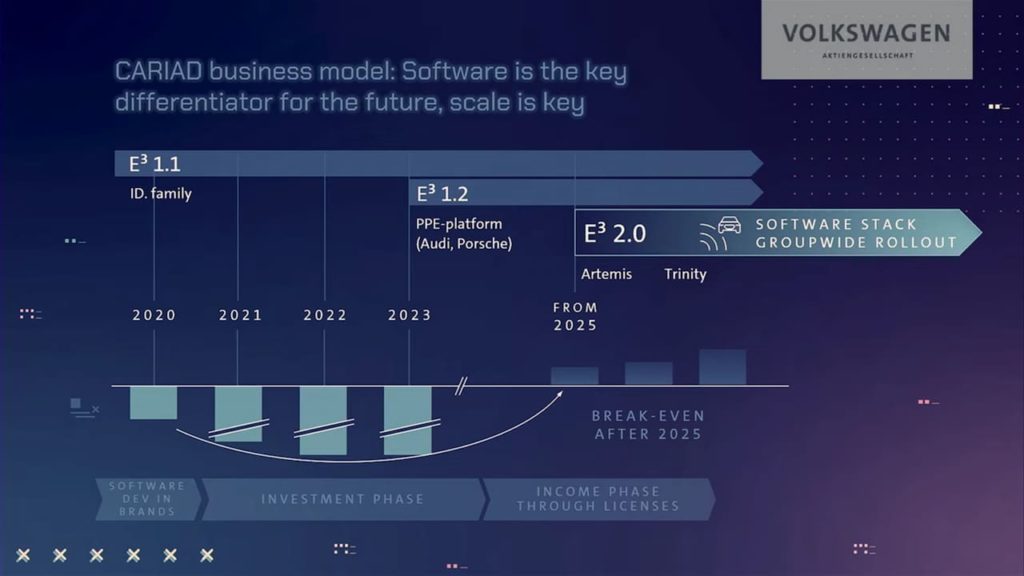
With CARIAD, we are fully committed to developing the leading automotive software stack in the industry. We are moving towards a synergetic business model. Most of the software-related R&D costs of the brand have been shifted to CARIAD, which will be reported as a standalone entity in the future. The CARIAD business model foresees a significant upfront investment phase of about 2 to 2.5 billion Euros per year. In the income phase, CARIAD will receive licensable fees paid by the brands or paid by potential third parties for the software use. This already started with the rollout of the ID family architecture.
Arno Antlitz, CFO, Volkswagen Group (Volkswagen Group New Auto strategy 2021)
Duesmann talked about the benefits of the E³ 2.0 software architecture at the New Auto strategy announcement event. He said:
When it comes to the advantages and performance of the SSP, E3 2.0 is probably the best example. Especially E³ 2.0 as one of the high-value modules will be the enabler for a growing portfolio of software services. Through this electronic architecture, we will be able to provide new functionalities quickly and efficiently to our customers across the group and we will realize significant economies of scale.
Markus Duesmann, CEO, Audi (Volkswagen Group New Auto strategy 2021)
Level 3 & Level 4 autonomous driving capability
VW and Bosch have joined hands to develop the software required to build Level 2+ and Level 3 autonomous driving capabilities for VW Group’s future cars, such as the Artemis project, according to an Automotive News report dated January 26, 2022. Bosch will get the marketing rights in the agreement, and VW will use Bosch’s AOS operating system for autonomous driving.
CARIAD CEO Dirk Hilgenberg told journalists on January 25, 2022, that the Bosch-VW partnership will help Audi catch up with the Artemis Project. Hilgenberg said that even though the brands will start work on Level 2+ and Level 3 technologies, the Artemis will also be Level 4 ready.
Level 2+ and Level 3 autonomous driving require considerable driver intervention and are not fully autonomous. However, Level 4 autonomous driving is a ‘High Automation’ level, where systems do not require inputs from the driver but their functions are limited to some areas—such as in a parking lot or on highways. The driver needs to take control when the vehicle leaves the defined areas, like when it drives into town.
Germany’s federal cabinet has passed the draft for fully autonomous driving, which would serve as the model for other EU countries. Mercedes-Benz already offers Level 3 autonomous driving in the country, as an optional package, with the S-Class. The Audi Landjet will be technically ready for Level 4 autonomous driving. In Level 4 on the highway, the driver would “no longer need to operate the car,” and so, he/she would “no longer have to be able to reach the steering wheel and the touchscreens” with hands all the time,” Lichte said.
Production
Volkswagen Group has allocated the Audi Artemis project production to Volkswagen Commercial Vehicles’ Hannover plant. The German factory will manufacture a slew of BEVs in the future.
Hannover would entirely change with the ID. Buzz. Launched next year, we are entering the BEV world. The most interesting German premium car, the Artemis, will be built in Hannover as well. In addition, we are expanding our body manufacturing for a new model of Bentley. With the MOIA shuttles and the ID. Buzz AD, this site will be spearheading autonomous driving. Hannover will be a technology driver for the entire group.
Dr. Herbert Diess, ex-CEO, Volkswagen Group (Supervisory Board meeting on December 9, 2021)
Release Date
Originally, Audi’s plan was to make the Artemis electric car available to customers in 2024. Various external and internal factors have officially delayed the release date to the second half of the decade.
For a few years now, Volkswagen Group has been announcing new software platforms and autonomous driving functions for its future electric cars, especially those originally scheduled for around 2025. However, these planned groundbreaking innovations are repeatedly pushing back launches, especially those from Audi and Porsche.
According to an Automobilwoche report dated December 5, 2022, the originally conceived Audi Artemis is dead. Oliver Blume, the CEO of Volkswagen Group (and also Porsche), has “pulled the plug” on the former prestigious project, the German publication said. Volkswagen Group hasn’t confirmed this rumor, but Blume has scheduled a new software strategy announcement on December 15, 2022, during which he could share an update on this matter.
For now, it’s best not to pin your hopes on the Audi Artemis electric car. It will probably go on sale closer to 2027 and the final car might not be as radical as Duesmann and other executives were pitching it back in 2020.
Previously, according to a report Automobilwoche published on July 10, 2022, Audi won’t conduct the launch until the end of 2026, perhaps even 2027. Investors, dealers, and prospective customers would surely be disappointed, but the German automaker has come up with an interim solution.
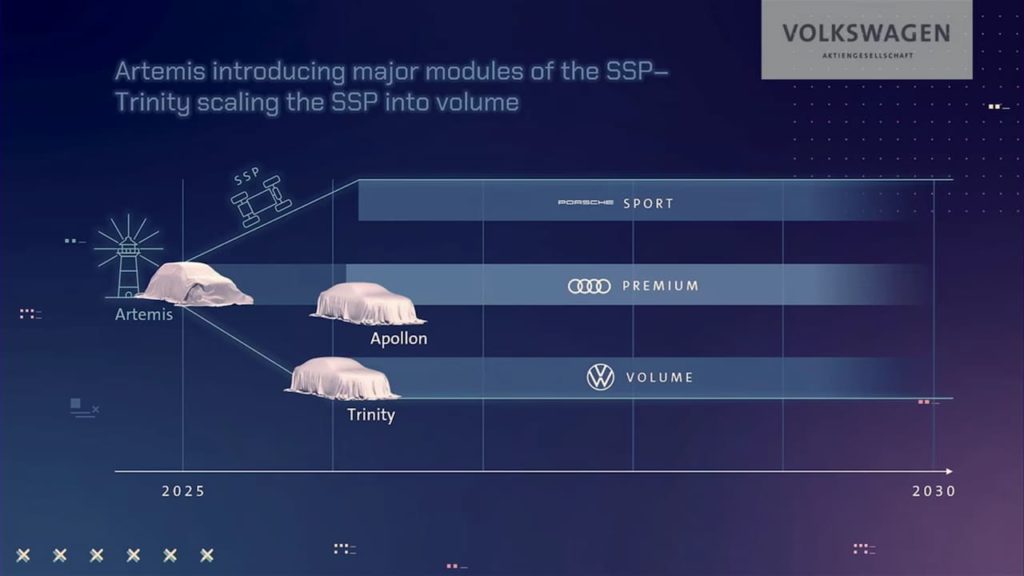
Automobilwoche claimed in the July 2022 report that Audi will launch “a slimmed-down version” of the originally planned model (that will now arrive in 2026 or 2027) with a “higher body shape” to fulfill its promise of releasing an efficient electric car from Artemis by the middle of the decade. Internally called ‘Audi Landyacht,’ this model won’t be as advanced with respect to autonomous driving capabilities, which could mean that it won’t support Level 4 hands-free driving, at least not at launch. Instead of Software 2.0, it’ll settle for Software 1.2.
Audi to focus on luxury models
Audi has confirmed that there would be no successor to the Q2, and the carmaker is not going ahead with developing a new A1. In early 2022, Duesmann told German business newspaper Handelsblatt that the VW Group has redefined the roles of its brands, and Audi has been realigned as a premium carmaker. As such, Audi is limiting its model range downward while expanding upward with cars like the Q8 e-tron, Artemis and Apollon.
Audi activesphere concept
The Audi activesphere concept is the fourth and final member of the Audi sphere family of concept cars. Like the other three EV models introduced progressively since August 2021, it has a unique character designed as per the needs of people with an active lifestyle.
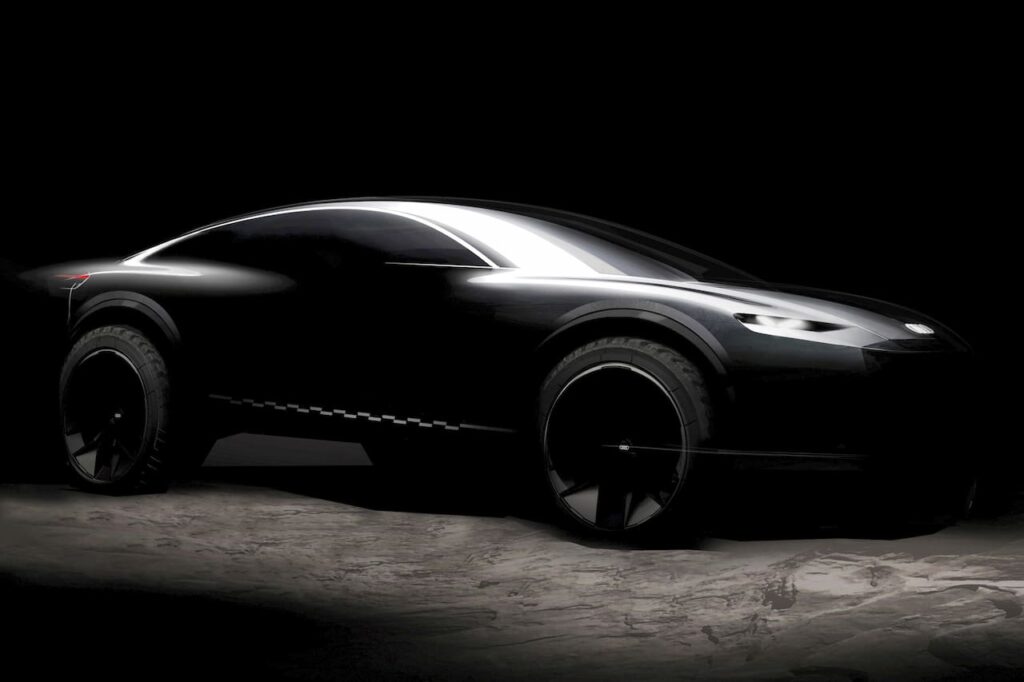
The activesphere concept is a soft off-roader that blends a poised two-door coupe with a few traits of an SUV, such as high ground clearance, black fender flares, knobby tires, etc. The show car flaunts an aggressive face with ultra-slim, angular headlights, an athletic side profile with oversized, protruding wheels, and a taut tail section. The finesse of a coupe is present all around, too. A long, low hood slopes down all the way to the front. The roofline, which is similarly low, swoops down to the short trunk lid. We’ll know more when Audi reveals the concept car in early 2023.
TopElectricSUV says
With some of Audi’s most futuristic technologies for drive components, in-cabin electronics, comfort features, and driver assistance systems, the Audi Landjet promises to be a groundbreaking product. Although it won’t be a sports car, this is likely to be the most exciting Audi to come out since the 2008 R8.
Audi Landjet/Audi Artemis FAQs
What is the Audi Landjet release date?
2026-27 is the much-awaited Landjet release date, which will ride on the PPE Platform with SSP modules.
What will be the Audi Landjet alternatives?
The Audi Landjet is expected to be an alternative to cars like the BMW i7, Lucid Air, Tesla Model S, and the Mercedes EQS.
What is the expected Audi Landjet price?
The starting price in the United States could be north of USD 90,000.
Featured Image Source: Audi
